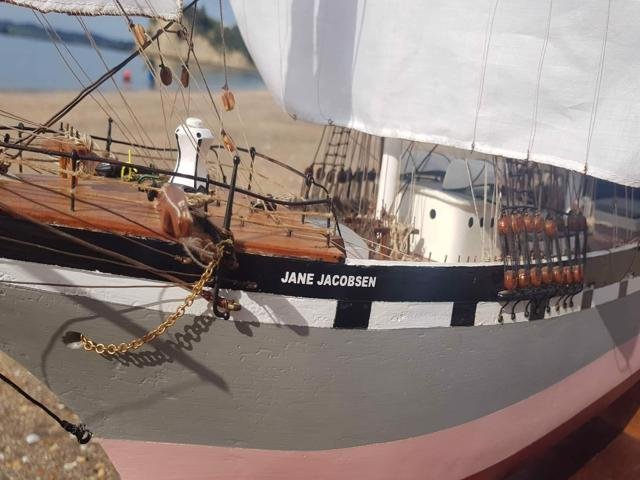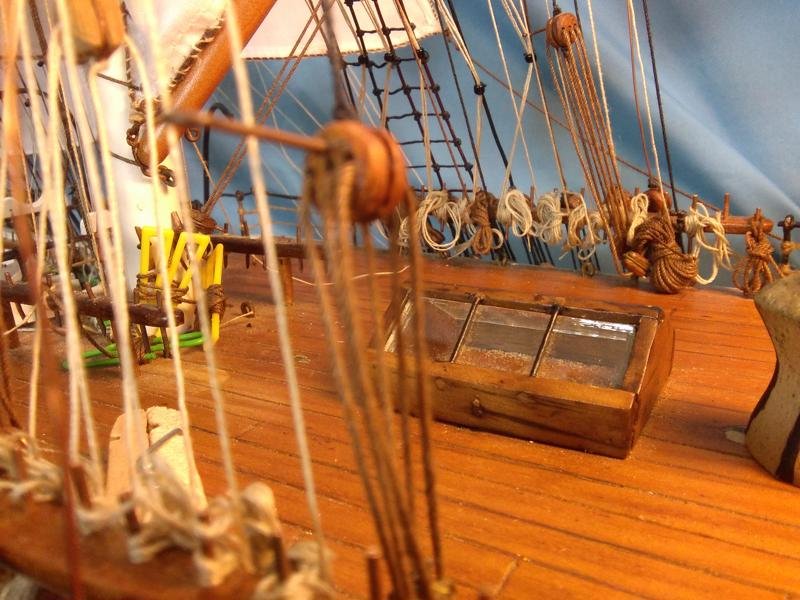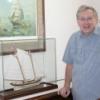-
Posts
83 -
Joined
-
Last visited
Content Type
Profiles
Forums
Gallery
Events
Everything posted by ikkypaul
-
"Splice the mainbrace, me hearties!"
ikkypaul replied to Renown1980's topic in New member Introductions
Welcome Stuart, I sense that you are setting out on quite a brave venture, but will succeed with your approach. All the best, from Down Under (NZ) Paul -
Welcome to MSW! Regarding learning the rigging, you'll soon learn as you start doing it! To look at a square rigged vessel it can seem terribly complex but the reality is that it is quite logical. And good instructions for rigging a model should show the lead of each line from the point it controls down to the relevant belaying pin at deck level. Patience is a necessary attribute too! I am sure you'll enjoy the process.
-
Welcome Dave, One thing I have learned is that patience is of increasing importance as you progress with a model, especially when putting up the running rigging. Enjoy! Paul
-
History of Full Rigged Sailing Ship Model built by Julius Huffam.docx
- 53 replies
-
- restoration
- clipper
-
(and 1 more)
Tagged with:
-
Keith, many thanks for your generous and kind comment. This restoration has been one of the most fulfiling experiences in my life, and made the more so because I see it as a lasting memorial to my uncle Julius who built it before just before 1899 and after serving as a soldier in WW1 and finally in the occupation force in Cologne Germany, died there in that phenomenal influenza epidemic in January 1919. It has been such a pleasure to be able to share the whole story of the ship and its builder with modelshipworld members. Paul Huffam
- 53 replies
-
- restoration
- clipper
-
(and 1 more)
Tagged with:
-
To Granpa Phil, Barkeater and Louie da fly, many thanks for your kind remarks, and to those who "liked"my efforts and result, a warm thank you too. It has been one of the most satisfying things I have done in my life. One discovery I have made is to find that the ship Antiope is very similar to the Jane Jacobsen in many details of its righ and main deck arrangements. (Written on back of painting: "'ANTIOPE' - Type: Ship (wool clipper) (?). Builder: Reid, Glasgow; August 1866. Dimensions: 242' 3" x 38' 4" x 23' 7". Tonnage: 1443.") Very best wishes to you all, Paul
- 53 replies
-
- restoration
- clipper
-
(and 1 more)
Tagged with:
-
Build Log. Restoration of Full Rigged Sailing Ship Model Posting #11, 17 June 2019 – Final instalment. To those kind modellers who have been following this project so far, my apologies for taking so long in bringing it all to completion. In the months since my last posting the work was mainly inspecting, adjusting and tidying up all aspects of the rigging. Some of these tasks: - setting the sails for almost running free, for wind coming fine over the starboard quarter (my preference) and this exercise spread over a couple of days. You can imagine removing each belaying pin, bracing each of the 18 square sails around plus sheeting the 9 fore and aft sails, and then belaying them all tidily as practicable. - setting up the rigging associated with the ship’s boats – for stowing the two on top of the deckhouse, making gripes for the two amidships and their hoisting gear (falls). - installing anchor cable securing and slipping arrangements. - replacing some lines (eg. braces) which had become very chafed over time. - repairs jibboom (bowsprit) rigging. 1. The highlight of the project was her re-launch on 17 November 2018. With the ship weighing 11 kg (24 lbs) and cradle 4.7 kg (10.4 lbs), gentle transportation for this fragile vessel in a motor vehicle and subsequently carrying her over the sand to the sea was an issue. My solution was the stretcher carrier shown below. The ships original cradle sits in a tray which is slung between removable poles. At a point just forward of the mainmast the ship was lashed down for security. Removal of the 2 metre poles facilitates use of a people mover vehicle, in which the ship sits athwartships for travel. Below are a few photos serve to round off the restoration’s completion. Should any one like to see any aspect not pictured please ask and I’ll try to oblige. I do have a very brief video of the model sailing – again, give me an email address so I can email it to you. Photos: 1. Newly named JANE JACOBSEN (after Jules' mother's maiden name) 2. Original figurehead 3. View from top of Mainmast 4. Arrangement of transportation 5. Replication of 1899 photo - Paul - with Auckland NZ's Rangitoto Island as backdrop 6. JANE JACOBSEN starboard tacking. I have written the full story of this model and about the life of Julius Huffam, and how I decided to name her the Jane Jacobsen, which I will post in the appropriate place in modelshipworld if allowed. The model has been gifted to the Motueka Museum near Nelson New Zealand.
- 53 replies
-
- restoration
- clipper
-
(and 1 more)
Tagged with:
-
Welcome indeed Stevo79 great to have you with us. Go well, I am certain you will find much support in this group. Bestwishes from NZ!
-
Welcome Sodburybungy, you seem to be well attuned to this handcraft because the results look a fine job. Go well in your challenge. A model I have recently completed is the restoration of a ship that I've had sitting in my workshop for over 50 years! All my very best wishes Paul
-
Hello! Question About Rehoming a Ship
ikkypaul replied to Charlie B's topic in New member Introductions
Charlie, thanky oufor bringing this up foro discussion. Only last month I completed a full restoration of a 3 masted full rigged ship (estimated scale 1:55) - hull length 1 metre - it was a very profound experience for I was restoring this ship that had been built by my uncle then aged 11 years old in 1899 (repeat 1899). And I have sailed it on the sea! My point is that - agreeing with the suggestion of Bob Cleek - it may well excite a young person to have a crack at restoring this model. Such a lot would be learned in the process. Good luck - it may turn out to be a real prize ship. Paul -
Hello all and already looking for help
ikkypaul replied to Signode388's topic in New member Introductions
Iliya - Welcome to this ship modelling world. Some excellent advice above - from folk who in some cases - like me - have learned from experience. I think my most used tool is the pair of fine tweezers - especially useful in tight corners and in handling the rigging. As I have progressed I often made up another tool for either poking or pulling lines to work on them. The advice to get a tool when you really need it if very sound. All the best. Paul -
Welcome Rob! It might seem a good idea to set yourself up with a comprehensive kit of tools, but I recommend just the few really obvious tools to begin with. You can add other tools as you come to need them. And on-line shopping helps in this regard. My current project is restoring a one metre long 3-masted square rigger (118 years old) and my most frequently used tool is a a pair of fine angle-tipped tweezers. Often I find that it is neccessary also to make up suitable tools or jigs for specific jobs. To me it is all part of the challenge. My very best wishes for success in your modelling. Paul (Auckland NZ)
-
Welcome Ron. Now is the time to get cracking again. It took me from 1968 to 2010 to start the main work on my project! But it is all coming to fruition now with quite a few tasks to cmplete. Go Well! Looking forward to seeing how you go. Paul
-
Members 71 posts Report post Pos Build Log. Restoration of Full Rigged Sailing Ship Model Posting #10 26 June 2018 By way of a supplement to my posting # 9, the photo of the Port poop fife rail shows what I was starting with – lines all over the place – very un-seaman like. For comparison of "before and after" I now place it here again along with a photo of the Starboard Poop Fife rail after belaying the lines using my line coiling device. Still not perfect but improving with practice!
- 53 replies
-
- restoration
- clipper
-
(and 1 more)
Tagged with:
-
Build Log. Restoration of Full Rigged Sailing Ship Model Posting #9 20 June 2018 The very vexed question for me over the past 3 months has been how to effectively coil the loose end of belayed lines in a presentable and tidy manner. I didn’t find any forum discussions on this particular task, although there must be quite a few modellers who have somehow met the challenge. Attached photos I think are self explanatory. The practical constraints to work within are: · In limited space a man’s fingers make it a very difficult job, · Being a working model, in my case, all lines have to be their functional length, · Lines also have to be workable to enable adjustments for sail handling. After many attempts I have devised a practical, albeit still a bit fiddly, device and technique. I hope the photos will help to clarify my solution. The parts of the device are: - a U shaped length of welding rod provide two prongs (tines), - a cut down length of a basic biro (ball-point) pen with endcap, - a thin cable tie, - small wooden wedge to push into biro and jam the cable-tie The tool used is a small end crochet hook. Method. 1. Feed thin end of cable-tie through the biro body to exit through the cap. 2. Feed protruding end of cable-tie back through the cap, thus forming a loop. 3. Place loop over one of the prongs. 4. Coil line (rope) on the prongs. 5. Bring cable-tie loop up and over the prong. 6. Tighten loop on the coil, and jam tight with wedge. 7. Remove coil from both prongs. 8. Make a few turns of line around the coil to give it a waist. 9. Poke a crochet hook through the one end of the coil towards the standing end of the line. 10. Hook onto the standing end of the line and pull it through the coil to form a loop. 11. Place the coil loop onto the belaying pin. JOB DONE! Note: if the lines are a bit springy I find moistening them with diluted PVA glue helps to make them behave better! (A tip I learned from a ship modelling book.)
- 53 replies
-
- restoration
- clipper
-
(and 1 more)
Tagged with:
-
Hello Rory ( some of my ancestors came from Yeovil, and settled in NZ) - love the photos , and trust you 'll enjoy model building with NRG MSW. welcome to this forum. Paul
-
Hello and welcome Ryzuhr I think you will find most of what you could need in Model Ship World. Get started! but sometimes be a bit patient with the tricky bits. All the best Paul NZ
-
Welcome Pete - what a mine of information and skills you bring with you. All success in your "change of tack".
Paul
-
G'day Greg (from further Down Under- Auckland) - what a ship building pedigree! What a lot of stories could be told too. Amost warm welcome to MSW. I trust you'll find it very satisfying.
-
Thanks for this info. Have just had a quick look at the photos - my model I agree is pretty close the the Wavertree which seems a little larger. I'll study her more later. This is the first time I have had a suggestion like yours. Many thanks. Paul (NZ)
- 53 replies
-
- restoration
- clipper
-
(and 1 more)
Tagged with:
-
Mark - a very warm welcome to MSW. I agree with the others' comments. In my progress on my project the main thing I need to have is patience, especially on a task that is repetitive and fiddly to do. And dont give up! All the best in this venture. Paul.
-
Thank you druxey, what is left is the proper belaying of the majority of the lines to their pins - a fiddly task, the proper stowage of all four boats, fitting the capstans and replacing a few frayed lines like the braces which have suffered during recent months.
- 53 replies
-
- restoration
- clipper
-
(and 1 more)
Tagged with:
-
Build Log. Restoration of Full Rigged Sailing Ship Model Posting #8 1 May 2018 Completing the fore and aft sails entailed making some “hanks” to attach the sail to the spanker gaff. These were contrived with copper wire bent as shown and capable of opening to fit onto the gaff without having to remove fixed fittings. A piece I meant to include in the last blog is this photo showing the holding of the sails in tension while stitching on the bolt-ropes. Then shows the set of square sails all with bolt ropes, aft’ side upwards! The bolt ropes are actually on the forward side. For a change of task the anchor rigging was made up – the lower purchase block fitted with a hook for attachment to the anchor shackle. Than two anchors were supplied from Cornwall Model Boats UK, www.cornwallmodelboats.co.uk/ and are as near to scale as available. The cat heads are the original ones. Bending on the square sails was fairly easy with the sheets, clew and bunt lines with “shackles” for attaching already in place. Shown here is the main royal sail bent on. Then came my 80th birthday celebrations, when all our extended family were present. It seemed an excellent opportunity to included a “Basin Trial” of the ship, albeit with only fore and aft sails plus the main square sails bent on. Very little else has been done since September, except to complete the bending on of the full suit of sails and making a start on the awkward task of properly belaying all the approximately 200 lines to their respective pins. By Christmas I had replaced the broken starboard poop fiferail and made a new one for the port side as well. For convenience both are a fraction longer than originally. So here she is as she will look, more or less, at full completion.
- 53 replies
-
- restoration
- clipper
-
(and 1 more)
Tagged with:
About us
Modelshipworld - Advancing Ship Modeling through Research
SSL Secured
Your security is important for us so this Website is SSL-Secured
NRG Mailing Address
Nautical Research Guild
237 South Lincoln Street
Westmont IL, 60559-1917
Model Ship World ® and the MSW logo are Registered Trademarks, and belong to the Nautical Research Guild (United States Patent and Trademark Office: No. 6,929,264 & No. 6,929,274, registered Dec. 20, 2022)
Helpful Links
About the NRG
If you enjoy building ship models that are historically accurate as well as beautiful, then The Nautical Research Guild (NRG) is just right for you.
The Guild is a non-profit educational organization whose mission is to “Advance Ship Modeling Through Research”. We provide support to our members in their efforts to raise the quality of their model ships.
The Nautical Research Guild has published our world-renowned quarterly magazine, The Nautical Research Journal, since 1955. The pages of the Journal are full of articles by accomplished ship modelers who show you how they create those exquisite details on their models, and by maritime historians who show you the correct details to build. The Journal is available in both print and digital editions. Go to the NRG web site (www.thenrg.org) to download a complimentary digital copy of the Journal. The NRG also publishes plan sets, books and compilations of back issues of the Journal and the former Ships in Scale and Model Ship Builder magazines.






